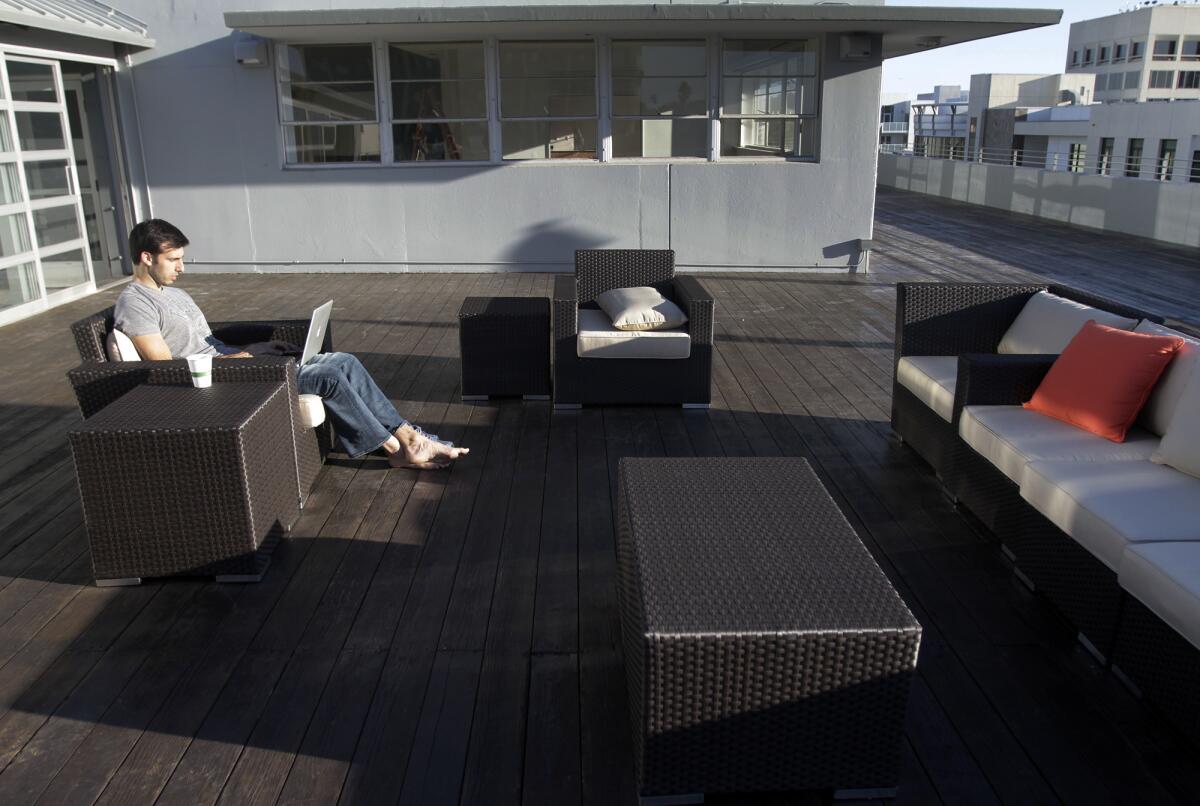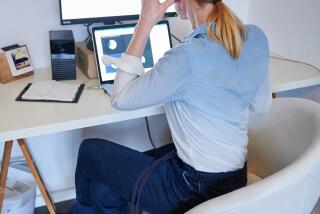Even for the active, a long sit shortens life and erodes health

Maybe those of us who sit for long hours in meetings, on phone calls, and tapping away at keyboards should be getting hazard pay. New research that distills the findings of 47 studies concludes that those of us who sit for long hours raise our average risk of cancer, cardiovascular disease, type 2 diabetes and early death.
Even for those of us who meet recommended daily levels of exercise, sitting for long periods of time boosts our likelihood of declining health. (In fact, I just worked out intensively for 90 minutes, and am now risking life and limb to bring you this news. Youâre welcome.)
To be sure, the latest research -- published Monday in the Annals of Internal Medicine -- finds that the risk of poor health âis more pronounced at lower levels of physical activity than at higher levels.â
Those who engage in regular physical activity but still spend a large proportion of their day in sedentary activity were found, on average, to be 30% less likely to die of any cause in a given period than were those who get little to no exercise. But even those who punctuate a long day of sitting with a vigorous workout were estimated to be 16% more likely to die of any cause in a given time than were those who do not sit for long.
MORE: Get our best stories in your Facebook feed >>
The studies that formed the basis for such aggregations defined prolonged sitting, as well as high levels of physical activity, quite differently. While one study included participants who spent as little as an hour a day seated, the rest defined prolonged sitting as those who watched television for at least five hours a day on up to those who had more than six and, in one study, more than 11 hours of âsitting timeâ a day.
Any way you read it, these studies probably sweep most of us into the long-sitting category, since researchers estimate that more than half of the average Americanâs waking life is spent sitting.
The compensating effects of exercise were also measured differently in each study. High levels of physical activity were variously defined as âmeeting physical activity guidelinesâ -- at least 20 minutes a day of moderately vigorous exercise -- to spending at least seven hours a week engaged in moderately vigorous exercise.
The amount of time spent sitting was found to drive up health risks independently of other factors that would often contribute to poor health and which might also be linked to sedentary behavior, such as smoking, age and obesity. That suggests, for example, that although long hours spent sitting might indeed contribute to weight gain, it is probably harmful even if it doesnât make you obese.
Five of the 47 studies included in this round-up of research looked at the effect of time spent sitting and the risk of developing diabetes, and the association was the strongest found in the current study.
The authors extrapolated from available research that those who spend long hours in sedentary activity are 90% more likely than those who donât to develop type 2 diabetes. That figure averages completely sedentary people with regular exercisers, and the study findings that researchers worked with werenât powerful enough to discern whether regular exercise mitigated that risk.
The likelihood of dying from cardiovascular disease rises less dramatically (about 18%) with long hours of sitting, as did the risk of cancers (between 13% and 16%). Studies observed higher rates of breast, colon, colorectal, endometrial and endothelial ovarian cancer among those who logged long hours in a chair.
The problem for researchers and for all of us, says an accompanying editorial, is that even this study of studies leaves us asking, exactly how much sitting is bad for you? At what level of prolonged sitting are you putting yourself at risk, and what effect would strategies such as periodic light exercise breaks have in mitigating added risk? The study also fails to tell us who is at greatest risk from sitting for long periods.
So what to do if your job, your commute or your choice of leisure-hours entertainment has you pinned to a chair for many hours a day? Although they do have a legion of new fans, not everybody has the space, flexibility and budget to use one of those standing desks that we hear so much about.
Dr. David Alter, senior scientist at the Toronto Rehabilitation Institute and a senior author of the paper, did offer some tips on ways to limit sitting and its impact. He recommends:
- While working at a desk, be sure to get up for one to three minutes every half-hour or so and move around.
- While watching TV, stand or exercise during the advertisements (and no, donât go stand at the open fridge or the pantry).
- Monitor how much you sit, and try to reduce it by realistic increments every week. You should aim for two to three fewer sedentary hours in a 12-hour day. A wearable monitor can help establish a baseline and assess progress toward a goal.
- Know that getting regular exercise is good for you regardless of what you do for the rest of the day: It will not only help reduce your sedentary time, it should lower your risk of illness and improve your survival prospects if you have no alternative to logging long hours in a chair.
Follow me on Twitter @LATMelissaHealy and âlikeâ Los Angeles Times Science & Health on Facebook.
ALSO
OpEd: Working the refs on nutrition science
Too thin to work? Fashion models should be benched if theyâre underweight, health experts say
FDA allows gay and bisexual men to donate blood, but only under certain condition







